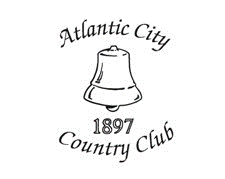 “Stay out of the bunkers” is the warning from the starter on the first tee, which also happens to be the putting green at Atlantic City Country Club.
“Stay out of the bunkers” is the warning from the starter on the first tee, which also happens to be the putting green at Atlantic City Country Club.
By the end of the day, I’d have said, “stay out of the marsh,” as the holes that wound along the coast proved to be exceptionally difficult on a particularly windy October day. With gusts around 35 mph, and blowing directly toward the water in most cases (and this is the prevailing wind, according to a local expert), the teeth of the course are really exposed on the back nine.
Course conditions
Noted architect Tom Doak’s work to restore the original design — including work done many decades earlier by the famed Willie Park and William Flynn — included looking at old pictures and maintaining what had been there, while upgrading and improving the track (a good interview here). With this in mind, it makes sense that the course retains its classically rustic feel, with tees very close to greens and a natural feel. But many of the improvement Doak made were aimed at maintaining superb conditions, specifically thanks to a new irrigation system and many of the modern touches you would expect at a course with a $200+ prime time green fee.
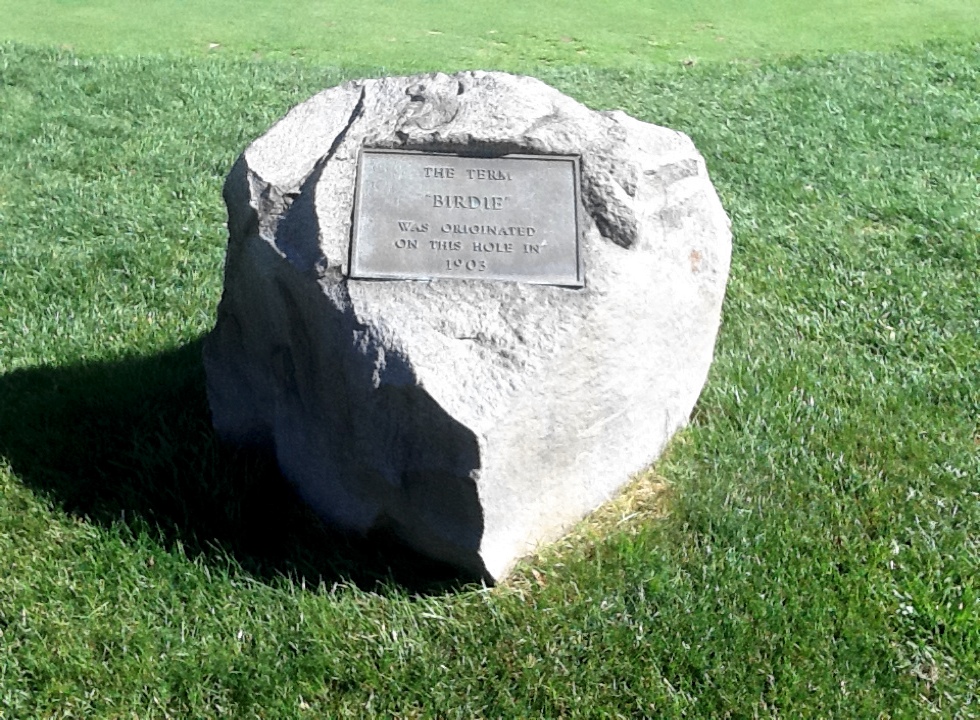
A rock and plaque commemorates Atlantic City Country Club’s origin of the term birdie.
On a recent visit, the greens rolled as true as anything I played all year, and they were mighty quick despite heavy rain the days prior to my round. The fairways drained nicely and showed no evidence of that recent rain. Tee boxes showed signs of play, but not abuse and throughout my round I saw crew on the course filling divots on tees and fairways.
Like most classic courses, ACCC isn’t manicured to the hilt, but this is also a product of the wild fescue and other native grasses you’d expect along the water. Cart paths existed where they should (including some nice boardwalk style inlayed wooden plan paths) but didn’t overrun the course.
Layout and Design
With two distinct flavors, ACCC plays like two designs.
On the dry holes, it plays like a classic inland course, with big bunkers framing shots, intimidating golfers off the tee and into greens, and forcing decisions standing over every shot. They are tough holes, but won’t bring you to your knees, especially if you miss in the proper spots.
On the holes bordering the water, your execution better be spot on, because the bail outs are either tiny, or very well hidden. When the wind is blowing, nature will work against you as much as any bunkering or other man-made obstacle.

Standing on the 14th tee, you’re surrounded on three sides by marsh. The temptation is to aim at the green, but with a prevailing wind blowing toward the water, this hole gets all the more difficult.
Built in 1897, ACCC is a beautiful example of classic golf course architecture. The single most obvious take-away during my 18 holes was how it presents the severe trouble and offers the player an option to play away from it. But in the process of playing safe, the course actually demands a more precise shot or else more problems await.
The best example of this comes on the 13th hole, a 553-yard par 5. Standing in the fairway, marsh lurks down the right side. The closer you play your second shot to the water, the better your approach into the green will be. Play it too safe and aim too far left away from trouble and you’re likely to find one of a series of fairway bunkers down the left side, setting up a 50-100 yard approach from the sand. In other words, the more you flirt with disaster, the better the reward. And if you think you can bail away from severe penalties, beware trouble lurking. Instead of the water hazard your avoiding, it might be a funky angle, some thick rough or another less-than-ideal shot. Either way, you’ll pay a price.
There’s a common criticism of ACCC, much like Pebble Beach, that the water holes are exceptional, but the inland holes are boring. I cannot agree with this at all. In the context of playing the six or so holes along the coast, you’ll get the “wow” factor, but that can’t diminish the rest of the course.
Some highlights, as seen through the eyes of a 4 handicap playing from the tips:
No. 1, 450-yard par 4: A stern start , but a wide fairway. Setting a tone for the day, the course shows you big trouble right, but the best angle to the green is right. Nasty bunkering awaits a shot played too cautiously left.
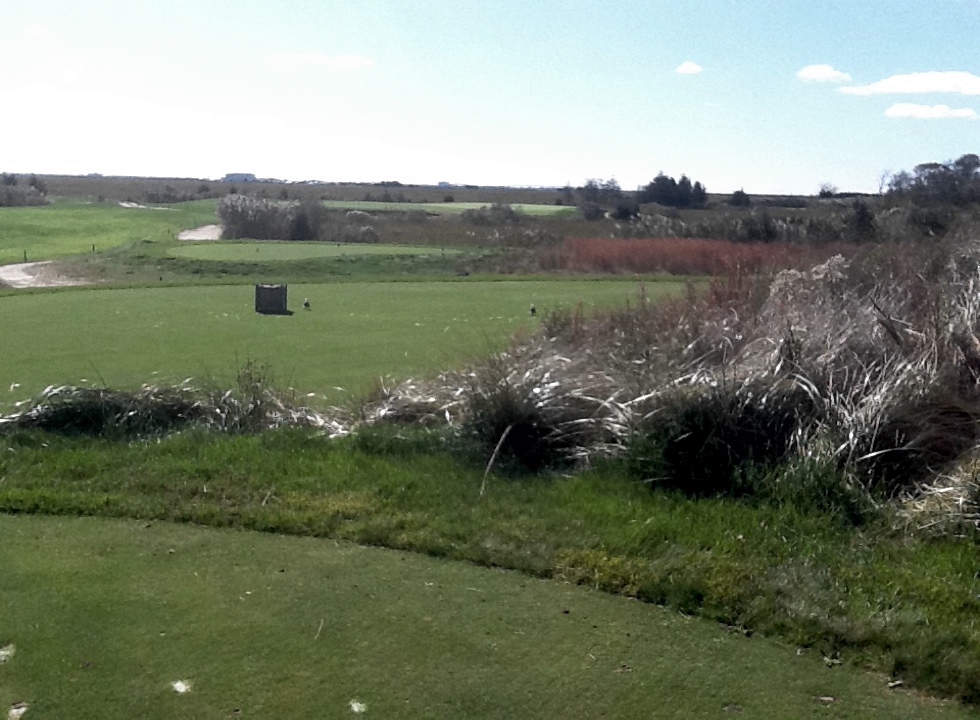
The approach to the second green must contend with deep bunkers. Find the proper side of the fairway to set up the ideal angle into the green.
No. 2, 368-yard par 4: Visually intimidating from the tee, with what appears to be a miniscule landing area, even for a short two-shot hole. Big imposing bunkers surround and cut into the fairway. Great approach, green framed nicely by mounds. Great green for short hole: Small, a nasty ridge on the front left and tucked neatly into a bunkered hillside.
No. 4, 144-yard par 3: It doesn’t take long to realize this is a special place. This wind-whipped par 3 is just a pitching wedge, but it’s not a pushover. The well-guarded target is subject to the elements as the first hole to play directly alongside the water. Distance control is crucial with problems awaiting long and short of the putting surface.
Nos. 5 through 9: This stretch of five long, demanding holes must be survived to card a decent score on the front nine. After a short-yet-testing start, ACCC puts together a stretch of three par 4s stretching beyond 450 yards, a par 3 of 196 and a par 5 just shy of 600. Like much of the inland holes, these five likely cost you a stroke here or there (rather than the debacle possible on the seaside holes), but strategy remains in play. Take for example, No. 9, a 452-yard dogleg left par 4. Cut off too much of the corner and bring OB into play, or deal with overhanging limbs that block shots from the left rough. Play it safe to the right and add 30 yards to your shot into the green. No. 9 captures much of the feel of the front nine nicely.
No. 10, 488-yard par 5: It’s becoming a recurring comment, but this short three-shot hole nicely sums up the challenges at ACCC. Take the most aggressive route off the tee — a drive challenging a deep fairway bunker — and you’ll have a reasonable shot to reach the green in two. However, a pond protects the green left (and narrows the landing area if you lay up). The natural bailout is right, but the green is designed with a steep right-to-left slant, making any pitch from the right of the green very dicey. Naturally, the bunker complex to the back-right of the green are extremely punishing.
No. 12, 134-yard par 3: On paper, and on the green, this should be the easiest hole on the course. But thanks to a bunker that obscures a large portion of the green, from the tee, this is a visually intimidating shot, and some of the deepest, most severe bunkers await a shot pulled left.
No. 13, 553-yard par 5: Playing into the prevailing wind, this will most likely be a three-shot par 5. As mentioned earlier, this is no routine hole and once again, the bolder you are in hitting toward the worst trouble, the greater the angle into the green. If you get too tentative, a long, awkward bunker shot will really test your game. Add in an unreceptive angle and trouble long and you’ll realize how important it is to be brave with your second shot.
No. 14, 339-yard par 4: Here’s where the course really gets its teeth into you. The first of the holes playing entirely along the sea, this tee box sits on a piece of land that puts you out into the marsh. On the day I was there, a howling wind into the face and toward the water. This short hole requires a tee shot over the marsh and depending on how much you bite off, you can end up wet, in a bunker right, in a bunker that catches balls long and left, or possibly even on the green. My tip: Wherever you think is safe, aim another 30 yards left. Even a drive well left will only leave a wedge to one of the toughest greens on the course, this one framed by bunkers left and water right. Probably the most memorable hole on the course.
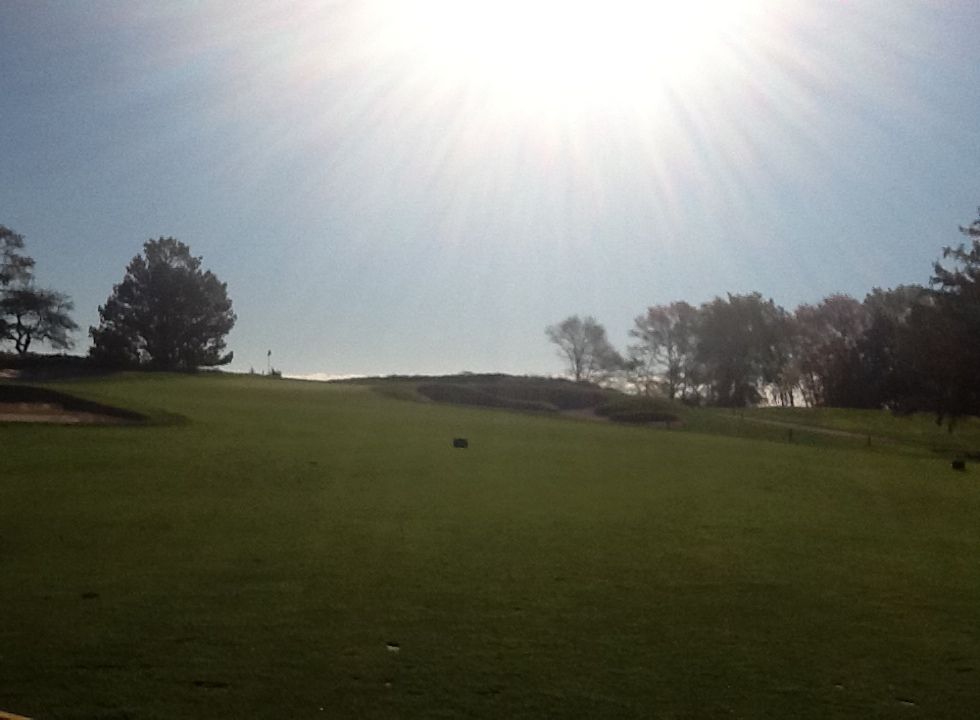
The par-3 15th hole presents one of the most demanding shots of the day at Atlantic City CC.
No. 15, 190-yar par 3: Given the conditions — a gusting wind off the right shoulder — this is one of the toughest par 3s I’ve played anywhere in the world. There’s simply no place to miss. Short right is wet. Long left is wet. Short is a bunker and anything long is likely gone. You’ll need your best long iron of the day for this one.
No. 16, 400-yard par 4: In the midst of this nasty stretch of golf holes comes one that sets up as tough as any hole on the course, even with a short iron in hand. Lots of green right but also marsh. If you bail left, you’ll face a massive bunker and waste area. Probably one of the 5 most visually intimidating holes I’ve ever played.
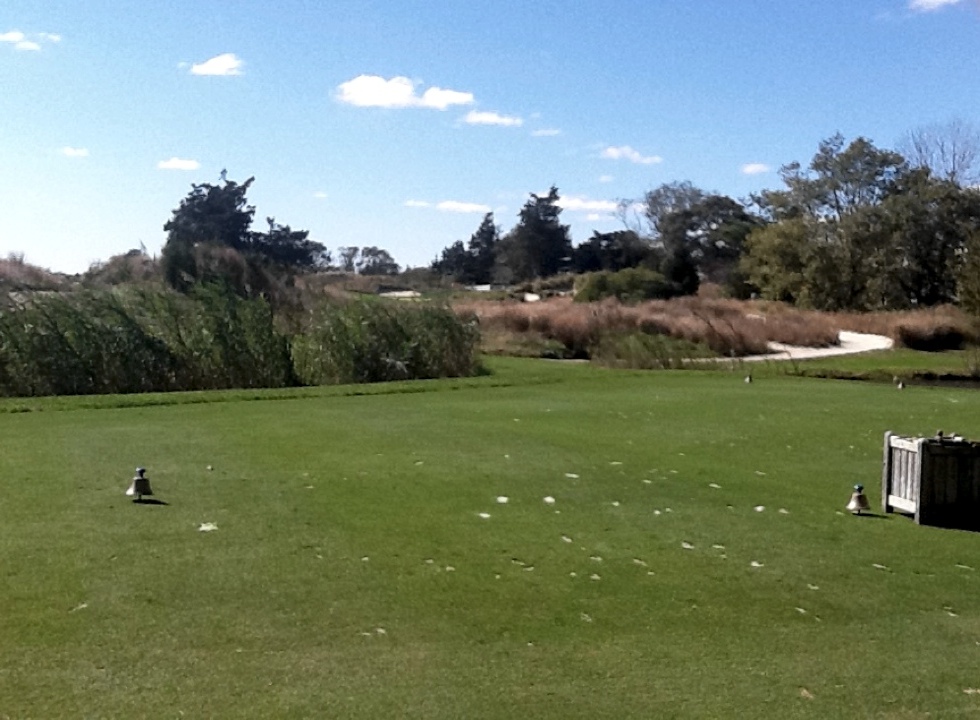
Even with a short iron in hand, the par-3 17th hole is daunting, thanks to a sand dune that obscures much of the green from the tee.
No. 17, 157-yard par 3: Another gorgeous yet daunting par 3 closes out the seaside holes, and while it’s no pushover, a good short iron will give a you fighting chance. But if you expect this round down simply, you haven’t been paying attention. A 20-foot sand dune stands guard on this well protected green. As with the three preceding holes, there are no relief areas, so gird up your loins and stick one close.
No. 18, 434-yard par 4: Returning to the clubhouse, this finisher offers a bit of a break and eases you home with a wide fairway and relatively straightforward finish. But this long par 4 will normally play into the teeth of the wind, leaving a closing par anything but a certainty.
Bang for the Buck
At the height of the season, greens fees reach $225, which puts it at the top of the top in the region. Most other Atlantic City courses top out right around $100, so ACCC certainly charges a premium. The course is memorable and would be the cornerstone of any golf trip.
However, once summer ends, prices drop significantly, with November rates falling as low as $60 during the week. Given the AC weather, where it stays warmer later into the year and the warm waterfront property promotes grass growth late into the fall, conditions are at their best when the rates are at their lowest. Playing Atlantic City Country Club during November for under $100 has to be one of the great deals in golf.
Conclusion
Atlantic City Country Club is a true gem. Once a strictly private club, then a home to the highest of high rollers from the casinos, ACCC is now open to all and sits atop most rankings of New Jersey’s best public courses. There’s no argument here. Any list of America’s great seaside courses needs to include Atlantic City Country Club.

Love Tom Doak’s work. Thanks for the review
The Royal Melbourne – the venue for President’s Cup is AUD 275 for a round. You are all welcome.
I’m gonna have to take a day off and play ACCC this Nov.